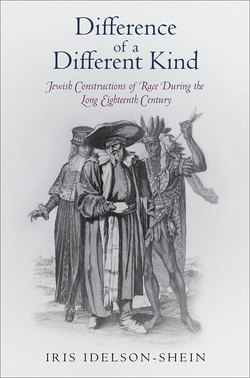Difference of a Different Kind

Реклама. ООО «ЛитРес», ИНН: 7719571260.
Оглавление
Iris Idelson-Shein. Difference of a Different Kind
Отрывок из книги
Difference of a Different Kind
Published in association with the Herbert D. Katz Center for Advanced Judaic Studies of the University of Pennsylvania
.....
Another characteristic of the corpus selected for this study has to do with language. Although the study engages texts written in Yiddish, German, German written in Hebrew characters, and other languages, the reader will notice that particular prominence is given to texts written in biblical Hebrew. This choice stems in part from the prominence given to biblical Hebrew by writers of the Haskalah. Of course, the importance of the Haskalah movement in the construction and proliferation of new modes of thinking throughout the eighteenth century and beyond grants maskilic thinkers a privileged position in the present study. Another reason for focusing on Hebrew works, and particularly Hebrew translations of non-Jewish works, is the unique intertextual nature of the biblical Hebrew used by the maskilim. Writing in biblical Hebrew opened up a world of associations to contemporaneous readers, which are not always immediately available to us today. Significantly, the use of biblical Hebrew was also a nod to thinkers of the non-Jewish Enlightenment(s), for whom the Bible supplied one of the few positive images of the Jew. Here was language that Christians viewed favorably, a language spoken by a people purportedly not corrupted by rabbinical Judaism/Hebrew on the one hand, or by life in Europe/Yiddish on the other. And yet, at the same time, the choice to write in Hebrew was also a choice to remain within the Jewish world, both in terms of language as well as in terms of readership. By choosing to write in Hebrew rather than in German or other non-Jewish languages, maskilic authors asserted their roles as harbingers of Jewish acculturation, while at the same time pledging their allegiance to Jewish tradition, community, and faith. In a way, writing in Hebrew constituted a choice to retain Jewish difference, but render it a difference of a different kind. Forgoing the hybrid Hebrew-Aramaic of rabbinical Judaism, and the equally hybridized Jewish-German or Yiddish spoken by the vast majority of European Jews, maskilic authors declared a kind of intellectual independence that took its inspiration from the image of “the native,” in this case the native Israelites. Indeed, one could perhaps say that for a brief moment in the eighteenth century the subaltern could speak in a language of its own. This language was Hebrew.
The first chapter focuses on representations of the savage woman, and particularly the savage mother, through a reading of the memoirs of the German Jewish merchant woman Glikl bas Leib. In her memoirs, written in Yiddish between the years 1691 and 1719, Glikl describes an erotic encounter between a pious Jew and an East Indian woman. Glikl’s story is, in fact, part of a tradition of colonial fantasies, such as the story of Pocahontas, or the tale of Inkle and Yarico, which envision the intercultural encounter as an erotic exchange. However, this specific version of the story, with its gruesome infanticidal twist and its incorporation of a highly unorthodox motif of male rape, is intriguing particularly in light of the writer’s personal background as a woman, a (bereaved) mother, and a Jew. In my analysis of Glikl’s story, I argue that her often radical departures from orthodox European paradigms of cross-cultural contact offer fascinating insights into the ways in which race and gender relate to one another during the early modern period. In addition, throughout the first chapter, I attempt to tackle the assimilation anxieties and inversion fantasies underlying Glikl’s story, and to locate them against their Jewish backdrop.
.....